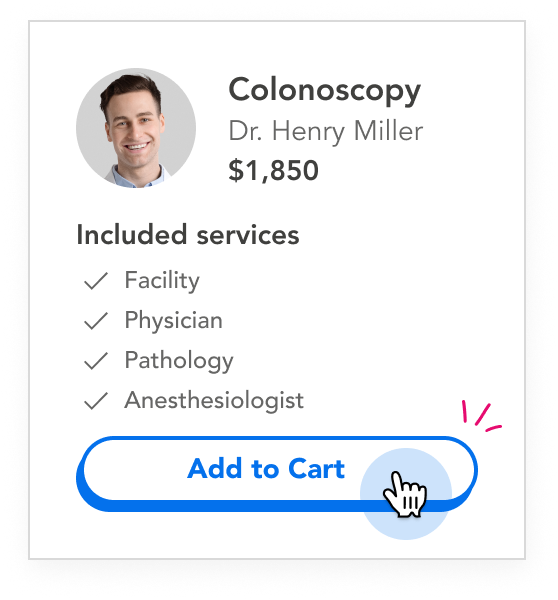
Physical Therapy Visit
(205) Reviews from people who purchased this procedureESTIMATED
NATIONAL AVERAGE
MDSAVE
NATIONAL AVERAGE
This includes one session of physical therapy.
How Much Does a Physical Therapy Visit Cost?
Purchase a Physical Therapy Visit today on MDsave. Costs range from $42 to $201. Those on high deductible health plans or without insurance can save when they buy their procedure upfront through MDsave. Read more about how MDsave works.Find Physical Therapy Visit providers near you
Search board-certified providers, compare prices, buy online, and save money.
What Our Customers Say
Browse 379 Providers in these Locations
Choose your location to find Physical Therapy Visit providers near you.
Shop with
Peace of Mind
Financing options
Promotional financing available when you pay with CareCredit. What is CareCredit?
MONEY BACK GUARANTEE
We will refund your payment in full if you end up not needing your purchased procedure and do not receive care. Details

Procedure Details
What Is Physical Therapy?
Physical therapy (PT) uses specially designed exercises and equipment to help you regain or improve your physical abilities. It aims to ease pain and help you function, move, and live better.
Physical therapy services are provided by physical therapists, who are professionals licensed by the state in which they work. They work closely with you to prevent injury or loss of functional mobility and help ensure a safe return to maximal function.1
Why is Physical Therapy Performed?
You may need physical therapy to:
- Relieve pain
- Improve movement
- Prevent or recover from an injury
- Work on balance
- Adapt to an artificial limb
- Help with a splint or brace
Not only does therapy treat a variety of health problems, but it also has been proven to reduce medical costs and save you money by diminishing the need for unnecessary medication, imaging scans, or surgeries. The ultimate goal of physical therapy is to help you to restore functional independence.2
How Should You Prepare?
To prepare for physical therapy, call to make an appointment and ask whether you should wear or bring a certain type of clothing. Your first physical therapy session (PT session) may include an initial evaluation, so make a list of any questions you have and be prepared to discuss any symptoms you’ve been experiencing. This will ensure you make the best use of your time with your physical therapist.
Physical therapy is performed in a variety of settings, including hospitals, skilled nursing facilities, rehabilitation facilities, at home or in an outpatient clinic.3
What Can You Expect During Physical Therapy?
During your initial evaluation, the physical therapist may evaluate and assess your overall condition . You may be asked to do physical exams to measure:
- Strength
- Balance
- Pain
- Range of motion
- Cardiac and pulmonary function
- Overall functional mobility
After gathering information about your injury or illness, the physical therapist will work with you to create a treatment plan and recommend the number of physical therapy sessions that you may need.4
Sufficient effort, as agreed between you and the physical therapist, is necessary to maximize the benefit from each treatment session. After your physical therapy care is completed, continue to follow the after-care instructions provided by the physical therapist.5
Is Physical Therapy Covered by Health Insurance?
Most insurance plans, including Medicare, cover physical therapy to some extent. However, the amount of coverage can vary depending on your plan.
If you have health insurance, you will typically be responsible for paying a copay or coinsurance for each physical therapy session. This can range from $10 to $75 per session, depending on your plan.
Medicare Part B also covers physical therapy, but you will be responsible for paying 20% of the Medicare-approved amount for each session. If you have a Medigap policy, it may cover some or all of your out-of-pocket costs.
It's important to check with your insurance provider to understand your specific coverage for physical therapy. Some insurance plans may have limits on the number of sessions covered or may require pre-authorization for treatment.
If you do not have insurance, including Medicaid or Medicare, or choose to not utilize it for physical therapy, MDsave offers attractive upfront physcial therapy prices from a range of quality therapists across the country.
How do Therapists Typically Bill Your Visit?
Physical therapists typically bill your visit using a Current Procedural Terminology (CPT) code. This code is used to identify the type of treatment you received during your session.6
For example, if you received manual therapy during your session, your therapist would use the CPT code 97140. If you received therapeutic exercises, they would use the CPT code 97110.
The CPT code is then submitted to your insurance company or Medicare for reimbursement. If you are paying out-of-pocket, the CPT code will be used to determine the cost of your visit.
On MDsave, your physical therapy visit purchase covers a range of different CPT codes for one single, upfront price. See the 'Procedure Description' for each provider's offer for the exact details on what is included.
1, 2, 4 Verywell Health. An Overview of Physical Therapy. https://www.verywellhealth.com/physical-therapy-4014670
3, 5 Move Forward. Preparing for Your Visit with a Physical Therapist. https://www.moveforwardpt.com/Resources/Prepare.aspx
6 Centers for Medicare & Medicaid Services. (2021). Physical Therapy Services. https://www.cms.gov/Outreach-and-Education/Medicare-Learning-Network-MLN/MLNProducts/Downloads/Physical-Therapy-Fact-Sheet-ICN905701.pdf
Patient Reviews
4.9
What did you like most about using MDsave?
It was self guided
What could we do to improve?
I don't see anything to improve thanks to your program I didn't have to use my insurance and it was a lot cheaper. By going through your site I didn't have to deal with my insurance and the headache that always comes with it.
What did you like most about using MDsave?
Saved me money
What could we do to improve?
All good
What did you like most about using MDsave?
I was out of covered visits through my insurance and MD save allowed me to be able to afford more visits
What could we do to improve?
None
What did you like most about using MDsave?
Easy to use
What could we do to improve?
I had a great experience
What did you like most about using MDsave?
Easy customer service and website friendly
What could we do to improve?
The entire experience was outstanding.
Get Care In Three Easy Steps
Compare Upfront Prices

Search by procedure and location to browse local providers and compare upfront pricing.
Buy Your Procedure

Pay for your procedure online or by calling (844) 256-7696. Or buy your procedure at the facility before your appointment is scheduled.
Receive Your Care

Follow the scheduling instructions given by your provider. Bring your voucher to your appointment.
Procedures
© Copyright 2025 MDsave Incorporated.
All Rights Reserved.